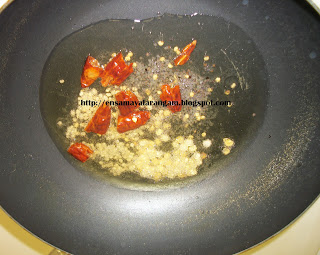Vathakuzhambu is a typical Brahmin household dish. I love the tangy tamarind taste of this dish and it goes best with steaming rice with a little bit of ghee and also with Venn Pongal. It is a very very simple dish to make and can be made with a variety of veggies like Okra, Shallots, Banana Squash, Taro Root, Drumsticks and Sweet Potato. It can also be made with dried Vathals like Manathakkali / Black NightShade and Sundakkai / Turkey Berry.
Ingredients:
Banana Squash - Chopped - 1 cup
Tamarind Concentrate - 1/2 cup
Sesame oil - 2 Tbsp
Mustard seeds - 1 tsp
Chana Dal - 1 tsp
Fenugreek Seeds - 1 tsp
Dry Red Chillies - 3-4
Turmeric Powder - 1 Tsp
Red Chilli Powder - 1Tsp
Asafoetida - A pinch
Sambar Powder/ Vathakuzhambu Powder - 1 Tbsp
Curry Leaves - A few
Cilantro - A few to garnish
Salt - To Taste
Method:
Ingredients:
Banana Squash - Chopped - 1 cup
Tamarind Concentrate - 1/2 cup
Sesame oil - 2 Tbsp
Mustard seeds - 1 tsp
Chana Dal - 1 tsp
Fenugreek Seeds - 1 tsp
Dry Red Chillies - 3-4
Turmeric Powder - 1 Tsp
Red Chilli Powder - 1Tsp
Asafoetida - A pinch
Sambar Powder/ Vathakuzhambu Powder - 1 Tbsp
Curry Leaves - A few
Cilantro - A few to garnish
Salt - To Taste
Method:
- Peel and cut the Banana Squash into bite sized pieces and keep it aside.
- Take a lime sized ball of tamarind and soak it in hot water and squeeze out the pulp concentrate in a bowl.
- If you are using tamarind paste, dissolve 1/2 tbsp of the paste in hot water and keep it aside.
- In a pan, heat the sesame oil and add the mustard seeds.
- Once the mustard seeds have popped, add the chana dal.
- Then add the fenugreek seeds and the dry red chillies.
- Add the Banana Squash and mix it well with the seasoning.
- Allow the squash to cook on medium heat for 3-4 minutes and add the tamarind concentrate to the squash.
- Add about 1/2 cup of water to the squash mixture.
- Then add turmeric powder and red chilli powder.
- Add a pinch of asafoetida and add some salt according to taste.
- Add Vathakuzhambu powder/ Sambar powder and cook for 3-4 minutes.
- Add some curry leaves to the Vathakuzhambu / Sambar.
- Allow the gravy to thicken. The Vathakuzhambu / Sambar has to reduce and form a sauce like consistency.
- Then add some Jaggery to this and simmer and cook for 5 minutes.

















































